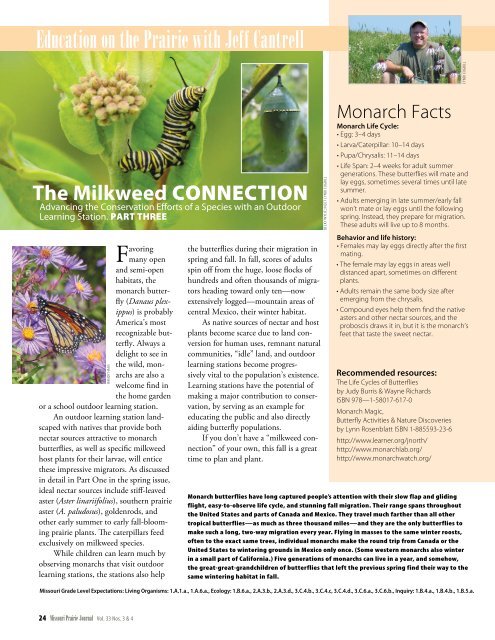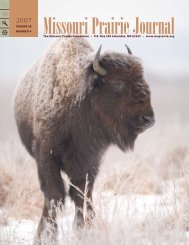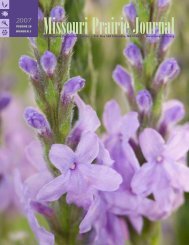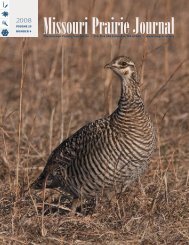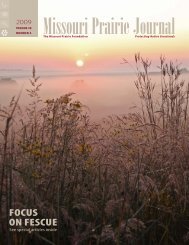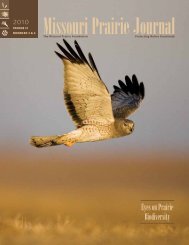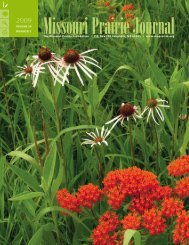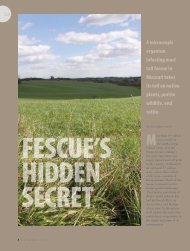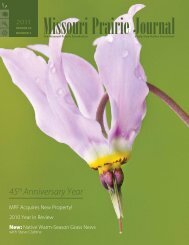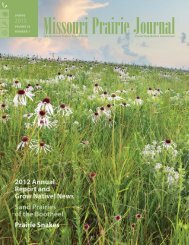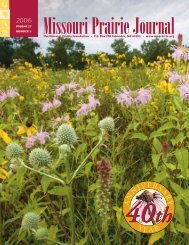Fall & Winter 2012: Volume 33, Numbers 3 & 4 - Missouri Prairie ...
Fall & Winter 2012: Volume 33, Numbers 3 & 4 - Missouri Prairie ...
Fall & Winter 2012: Volume 33, Numbers 3 & 4 - Missouri Prairie ...
You also want an ePaper? Increase the reach of your titles
YUMPU automatically turns print PDFs into web optimized ePapers that Google loves.
Education on the <strong>Prairie</strong> with Jeff Cantrell<br />
cyndi cogbill<br />
The Milkweed Connection<br />
Advancing the Conservation Efforts of a Species with an Outdoor<br />
Learning Station. PART THREE<br />
Favoring<br />
many open<br />
and semi-open<br />
habitats, the<br />
monarch butterfly<br />
(Danaus plexippus)<br />
is probably<br />
America’s most<br />
recognizable butterfly.<br />
Always a<br />
delight to see in<br />
the wild, monarchs<br />
are also a<br />
welcome find in<br />
the home garden<br />
or a school outdoor learning station.<br />
An outdoor learning station landscaped<br />
with natives that provide both<br />
nectar sources attractive to monarch<br />
butterflies, as well as specific milkweed<br />
host plants for their larvae, will entice<br />
these impressive migrators. As discussed<br />
in detail in Part One in the spring issue,<br />
ideal nectar sources include stiff-leaved<br />
aster (Aster linariifolius), southern prairie<br />
aster (A. paludosus), goldenrods, and<br />
other early summer to early fall-blooming<br />
prairie plants. The caterpillars feed<br />
exclusively on milkweed species.<br />
While children can learn much by<br />
observing monarchs that visit outdoor<br />
learning stations, the stations also help<br />
Randy Haas<br />
the butterflies during their migration in<br />
spring and fall. In fall, scores of adults<br />
spin off from the huge, loose flocks of<br />
hundreds and often thousands of migrators<br />
heading toward only ten—now<br />
extensively logged—mountain areas of<br />
central Mexico, their winter habitat.<br />
As native sources of nectar and host<br />
plants become scarce due to land conversion<br />
for human uses, remnant natural<br />
communities, “idle” land, and outdoor<br />
learning stations become progressively<br />
vital to the population’s existence.<br />
Learning stations have the potential of<br />
making a major contribution to conservation,<br />
by serving as an example for<br />
educating the public and also directly<br />
aiding butterfly populations.<br />
If you don’t have a “milkweed connection”<br />
of your own, this fall is a great<br />
time to plan and plant.<br />
Becky Wylie; inset CYNDi COGBILL<br />
Monarch Facts<br />
Monarch Life Cycle:<br />
• Egg: 3–4 days<br />
• Larva/Caterpillar: 10–14 days<br />
• Pupa/Chrysalis: 11–14 days<br />
• Life Span: 2–4 weeks for adult summer<br />
generations. These butterflies will mate and<br />
lay eggs, sometimes several times until late<br />
summer.<br />
• Adults emerging in late summer/early fall<br />
won’t mate or lay eggs until the following<br />
spring. Instead, they prepare for migration.<br />
These adults will live up to 8 months.<br />
Behavior and life history:<br />
• Females may lay eggs directly after the first<br />
mating.<br />
• The female may lay eggs in areas well<br />
distanced apart, sometimes on different<br />
plants.<br />
• Adults remain the same body size after<br />
emerging from the chrysalis.<br />
• Compound eyes help them find the native<br />
asters and other nectar sources, and the<br />
proboscis draws it in, but it is the monarch’s<br />
feet that taste the sweet nectar.<br />
Recommended resources:<br />
The Life Cycles of Butterflies<br />
by Judy Burris & Wayne Richards<br />
ISBN 978—1-58017-617-0<br />
Monarch Magic,<br />
Butterfly Activities & Nature Discoveries<br />
by Lynn Rosenblatt ISBN 1-885593-23-6<br />
http://www.learner.org/jnorth/<br />
http://www.monarchlab.org/<br />
http://www.monarchwatch.org/<br />
Monarch butterflies have long captured people’s attention with their slow flap and gliding<br />
flight, easy-to-observe life cycle, and stunning fall migration. Their range spans throughout<br />
the United States and parts of Canada and Mexico. They travel much farther than all other<br />
tropical butterflies—as much as three thousand miles—and they are the only butterflies to<br />
make such a long, two-way migration every year. Flying in masses to the same winter roosts,<br />
often to the exact same trees, individual monarchs make the round trip from Canada or the<br />
United States to wintering grounds in Mexico only once. (Some western monarchs also winter<br />
in a small part of California.) Five generations of monarchs can live in a year, and somehow,<br />
the great-great-grandchildren of butterflies that left the previous spring find their way to the<br />
same wintering habitat in fall.<br />
<strong>Missouri</strong> Grade Level Expectations: Living Organisms: 1.A.1.a., 1.A.6.a., Ecology: 1.B.6.a., 2.A.3.b., 2.A.3.d., 3.C.4.b., 3.C.4.c, 3.C.4.d., 3.C.6.a., 3.C.6.b., Inquiry: 1.B.4.a., 1.B.4.b., 1.B.5.a.<br />
24 <strong>Missouri</strong> <strong>Prairie</strong> Journal Vol. <strong>33</strong> Nos. 3 & 4


